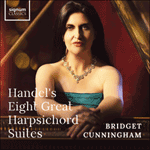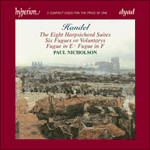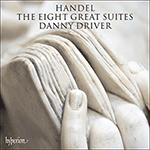
Welcome to Hyperion Records, a British classical label devoted to presenting high-quality recordings of music of all styles and from all periods from the twelfth century to the twenty-first.
Hyperion offers both CDs, and downloads in a number of formats. The site is also available in several languages.
Please use the dropdown buttons to set your preferred options, or use the checkbox to accept the defaults.

from notes by Wilfrid Mellers © 1995
extrait des notes rédigées par Wilfrid Mellers © 1995
Français: Isabelle Dubois
aus dem Begleittext von Wilfrid Mellers © 1995
Deutsch: Angelika Malbert
 Handel: Eight Great Harpsichord Suites Handel: Eight Great Harpsichord SuitesPublished under Royal Privilege in November 1720, Handel's 'Suites de Pièces pour le Clavecin' rapidly gained in popularity across Europe. Better known these days as the 'Eight Great Harpischord Suites', they are here performed on an instrument si ...» More |
 Handel: Harpsichord Suites Handel: Harpsichord Suites‘Superbly recorded. Highly recommended and unlikely to be surpassed in the near future’ (The Penguin Guide to Compact Discs) ‘The commanding nature of these performances, captured in sound of tremendous presence, cannot be denied. Nicholson captures a Handelian dignity and g ...» More |
 Handel: The Eight Great Suites Handel: The Eight Great SuitesDanny Driver’s recordings of CPE Bach’s keyboard works have been much admired: praised by critics as deeply stylish and revelatory accounts of eighteenth-century works on a modern piano, with Driver’s impeccable pianism constantly present. Now he ...» More |

